确定紧急手术路径的医疗报告结果的德尔菲过程
IF 3.7
3区 医学
Q1 ANESTHESIOLOGY
引用次数: 0
摘要
随着人们对高质量医疗保健需求的增长,迫切需要一种综合的方法来评估医院护理质量。由于缺乏标准化,很难比较不同研究的紧急手术结果。本组采用改进的德尔菲方法来确定评估紧急外科护理时应报告或比较的结果。方法于2024年5月至10月进行三轮德尔菲调查。它是由来自16个国家的外科医学专家组成的国际小组进行的。我们的目的是在2级共识评估的基础上,选择报告紧急手术通路的结果。最初,87个项目被分类在8个标题下。经过第二轮德尔菲分析,选出了26个结果。需要进行第三轮投票来确认另外3个结果。在选定的结局中,住院或30天死亡率,15个项目涉及围手术期发病率,以及与患者旅程相关的因素:术前(手术等待时间),术中(手术出血)和术后方面(选定的9个项目)。值得注意的是,没有保留“患者满意度”和“医学经济学”标题中的项目。小组成员认为有必要使用多标准结果(即结合8个标题中的项目)来评估紧急手术治疗途径。结论29项相关结果将有助于制定一套更全面的紧急外科护理评估方法。它能够制定新的优先次序政策,并更好地研究紧急手术的结果。值得注意的是,缺乏经济标准和患者满意度措施。本文章由计算机程序翻译,如有差异,请以英文原文为准。
A Delphi process to define medical reporting outcomes for urgent surgical pathways
Background
As the demand for high-quality healthcare grows, there is a pressing need for comprehensive methods to assess the quality of hospital care. Lack of standardization makes it difficult to compare urgent surgical outcomes across studies. Our group used a modified Delphi methodology to define the outcomes that should be reported or compared when evaluating urgent surgical care.
Methods
This three-round Delphi process took place from May to October 2024. It was conducted with an international panel of medico-surgical experts from 16 countries. We aimed to select, based on a 2-level consensus assessment, reporting outcomes for urgent surgical pathways.
Results
Initially, 87 items were classified under 8 headings. 26 outcomes were selected after the second Delphi round. A third round was required to validate 3 additional outcomes. Among the selected outcomes were in-hospital or 30-day mortality, 15 items addressing perioperative morbidity, as well as factors related to the patient journey: preoperative (surgical waiting time), intraoperative (surgical bleeding), and postoperative aspects (9 items selected). Notably, no items from the ‘patient satisfaction’ and ‘medico-economics’ headings were retained. Panelists deemed it essential to use multi-criteria outcomes (i.e., combining items from the 8 headings) to evaluate urgent surgical care pathways.
Conclusions
A set of 29 relevant outcomes will help to develop a more comprehensive approach for urgent surgical care evaluation. It enables the development of new prioritization policies and a better study of outcomes for urgent surgeries. It is worth noting the lack of economic criteria and patient satisfaction measures.
求助全文
通过发布文献求助,成功后即可免费获取论文全文。
去求助
来源期刊

Anaesthesia Critical Care & Pain Medicine
ANESTHESIOLOGY-
CiteScore
6.70
自引率
5.50%
发文量
150
审稿时长
18 days
期刊介绍:
Anaesthesia, Critical Care & Pain Medicine (formerly Annales Françaises d''Anesthésie et de Réanimation) publishes in English the highest quality original material, both scientific and clinical, on all aspects of anaesthesia, critical care & pain medicine.
 求助内容:
求助内容: 应助结果提醒方式:
应助结果提醒方式:


